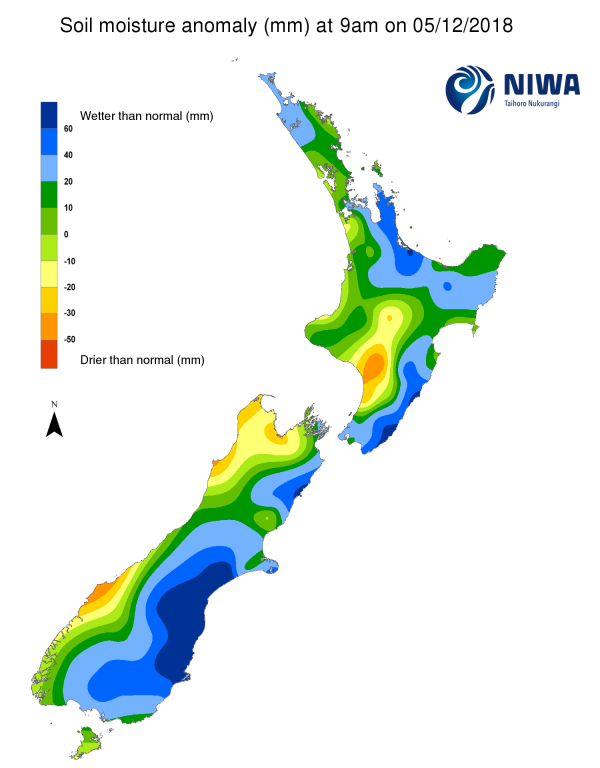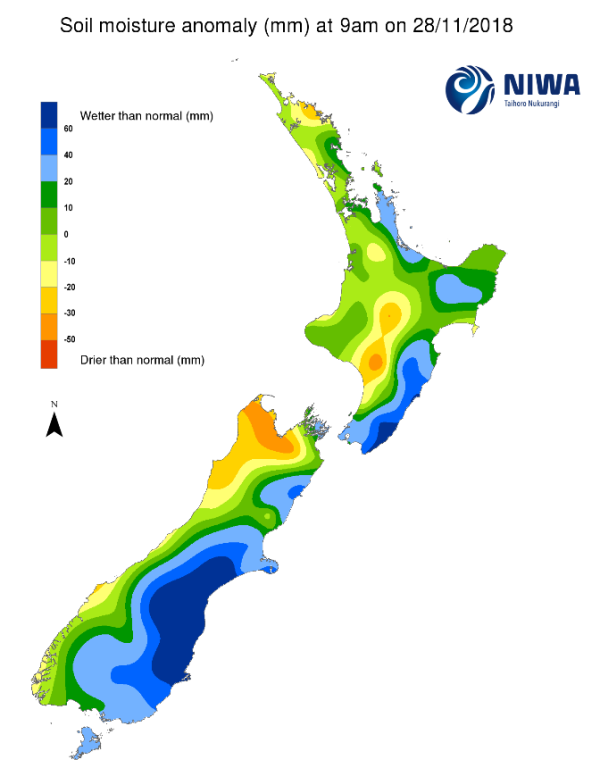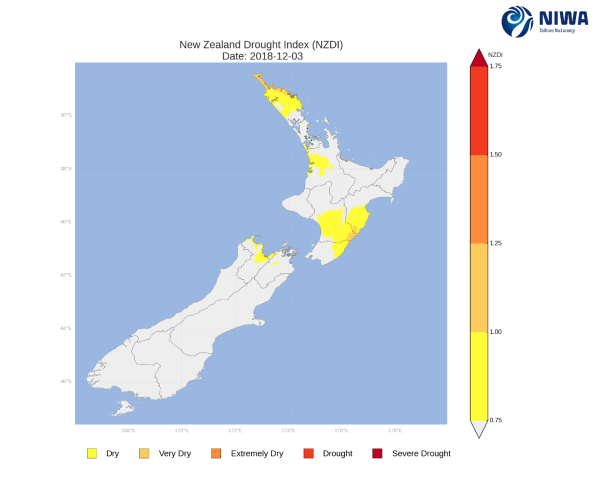A weekly update describing soil moisture across the country to help assess whether severely to extremely dry conditions are occurring or imminent. Regions experiencing these soil moisture deficits are deemed “hotspots”. Persistent hotspot regions have the potential to develop into drought.
Facts: Soil Moisture
Across the North Island, soil moisture levels generally improved during the past week due to significant rainfall. While improvements were observed nearly everywhere, the most notable increase over the past week occurred in Northland, where soils went from drier than normal to near or wetter than normal for the time of year. Impressive soil moisture increases were also experienced in the Coromandel Peninsula and the Bay of Plenty. The only area that saw soil moisture decrease during the past week was parts of the Rangitikei District in Manawatu-Wanganui.
The driest soils across the North Island compared to normal for this time of the year are found in central and coastal Manawatu-Whanganui, while the wettest soils for this time of the year are in coastal Wairarapa and western Bay of Plenty. A new hotspot emerged in the Rangitikei District in Manawatu-Wanganui during the past week. This is the only current hotspot in the North Island.
Across the South Island, soils remained much wetter than normal for the time of year from central Canterbury to Southland. In addition, soil moisture increases occurred in the Kaikoura District and northern Tasman due to significant rainfall. Conversely, soil moisture levels decreased in southwestern West Coast region.
The driest soils across the South Island compared to normal for this time of the year are found in far western Buller district along with the southwestern West Coast region. There are currently no hotspots in the South Island.
Outlook and Soil Moisture
In the North Island, the unsettled weather will continue on Thursday (6th December). The heaviest rain is expected in the higher terrain in southern Manawatu-Wanganui where rainfall amounts may exceed 30mm. Rainfall should generally stay below 15 mm for the rest of the island. After a prolonged period of unsettled weather, high pressure is building in on Friday (7th December) and should bring a few days of mostly dry and settled conditions.
Low pressure arriving from the Tasman with an associated front may bring unsettled weather mainly to central and lower North Island starting early next week (Monday 10th December). The most significant rainfall is expected in Bay of Plenty, the Central Plateau and parts of Gisborne and Hawke’s Bay where rainfall totals in the next week may exceed 40 mm. Drier conditions are likely in the upper North Island with total rainfall amounts generally below 15 mm.
With the rainfall amounts anticipated in the next week, additional soil moisture improvements are likely parts of the central and eastern North Island with the greatest potential for soil moisture increase from the eastern Bay of Plenty through to the Hawke’s Bay regions, particularly in the higher terrain. Soil moisture levels will likely remain the same or decrease for the remainder of the island.
For the South Island, high pressure should bring mostly settled weather to central and northern regions over the weekend. But a weak front can bring up to 15 mm of total rainfall (through Sunday 9th December) to Southland and Otago with higher rainfall amounts in costal Fiordland. More unsettled weather may return to the South Island starting early next week (Monday 10th December) and showers are expected to linger through Thursday (13th December). The most significant rainfall will likely occur in north and east.
The largest rain totals in the upcoming week is expected in coastal Fiordland, Canterbury high country and the Tasman region where total rainfall may exceed 50 mm. Consequently, soil moisture levels will likely increase from eastern Marlborough south through to mid-Canterbury. Other locations will likely have little change or decrease slightly as weekly rainfall is expected to be normal or below normal.
The New Zealand Drought Index (NZDI) map below shows continuing dry and very dry areas across the North Island and upper South Island as of 3 December. However, rainfall in the past days and next week may lead to some improvements. Please note: the soil moisture anomaly map may not correspond with the NZDI map, mainly because the NZDI uses additional dryness indices including one which integrates the rainfall deficit over the past 60 days. Changes are therefore slower to appear in the NZDI compared to the instantaneous status maps of soil moisture anomaly.
Background:
Hotspot Watch: a weekly advisory service for New Zealand media. It provides soil moisture and precipitation measurements around the country to help assess whether extremely dry conditions are imminent.
Soil moisture deficit: the amount of water needed to bring the soil moisture content back to field capacity, which is the maximum amount of water the soil can hold.
Soil moisture anomaly: the difference between the historical normal soil moisture deficit (or surplus) for a given time of year and actual soil moisture deficits.
Definitions: “Extremely” and “severely” dry soils are based on a combination of the current soil moisture status and the difference from normal soil moisture. Refer to soil moisture maps for more information.



